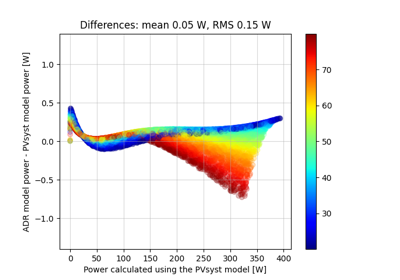pvlib.pvsystem.max_power_point#
- pvlib.pvsystem.max_power_point(photocurrent, saturation_current, resistance_series, resistance_shunt, nNsVth, d2mutau=0, NsVbi=inf, method='brentq')[source]#
Given the single diode equation coefficients, calculates the maximum power point (MPP).
- Parameters:
photocurrent (numeric) – photo-generated current [A]
saturation_current (numeric) – diode reverse saturation current [A]
resistance_series (numeric) – series resitance [ohms]
resistance_shunt (numeric) – shunt resitance [ohms]
nNsVth (numeric) – product of thermal voltage
Vth[V], diode ideality factorn, and number of serices cellsNsd2mutau (numeric, default 0) – PVsyst parameter for cadmium-telluride (CdTe) and amorphous-silicon (a-Si) modules that accounts for recombination current in the intrinsic layer. The value is the ratio of intrinsic layer thickness squared \(d^2\) to the diffusion length of charge carriers \(\mu \tau\). [V]
NsVbi (numeric, default np.inf) – PVsyst parameter for cadmium-telluride (CdTe) and amorphous-silicon (a-Si) modules that is the product of the PV module number of series cells
Nsand the builtin voltageVbiof the intrinsic layer. [V].method (str) –
either
'newton','brentq', or'chandrupatla'.Note
'chandrupatla'requires scipy 1.15 or greater.
- Returns:
OrderedDict or pandas.DataFrame –
(i_mp, v_mp, p_mp)
Notes
Use this function when you only want to find the maximum power point. Use
singlediode()when you need to find additional points on the IV curve. This function uses Brent’s method by default because it is guaranteed to converge.
Examples using pvlib.pvsystem.max_power_point#

Fast simulation using the ADR efficiency model starting from PVsyst parameters
